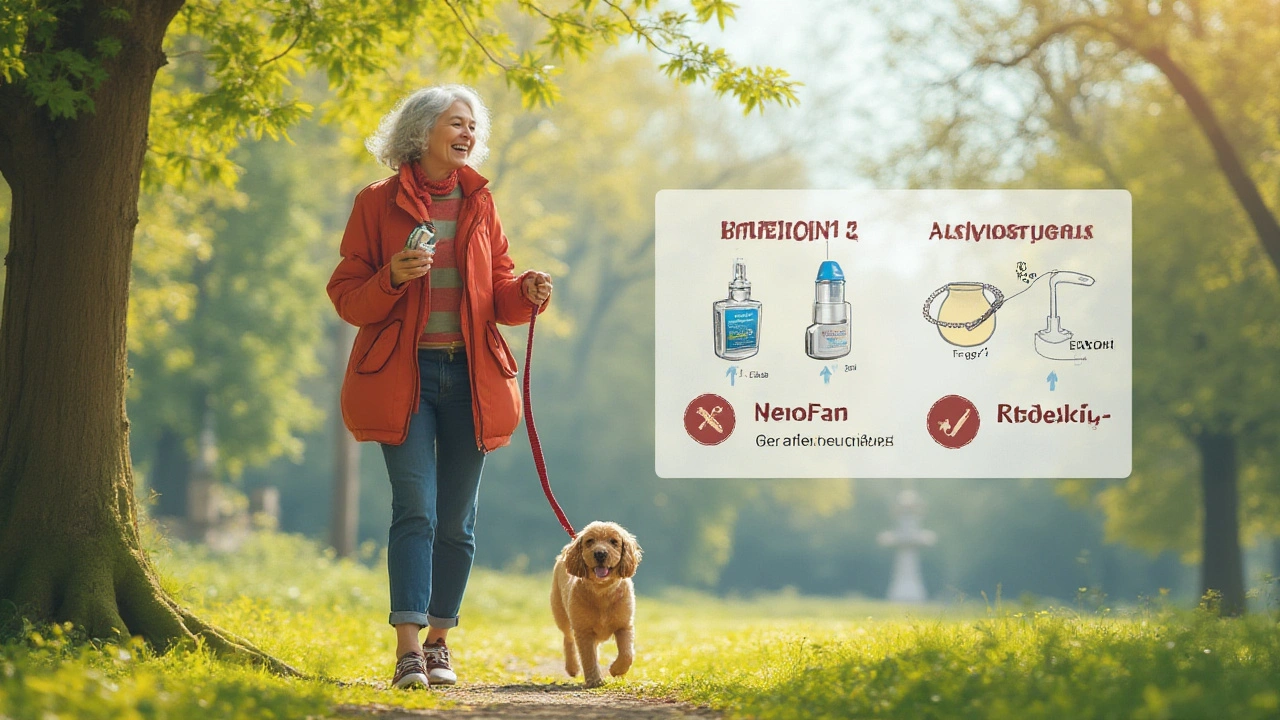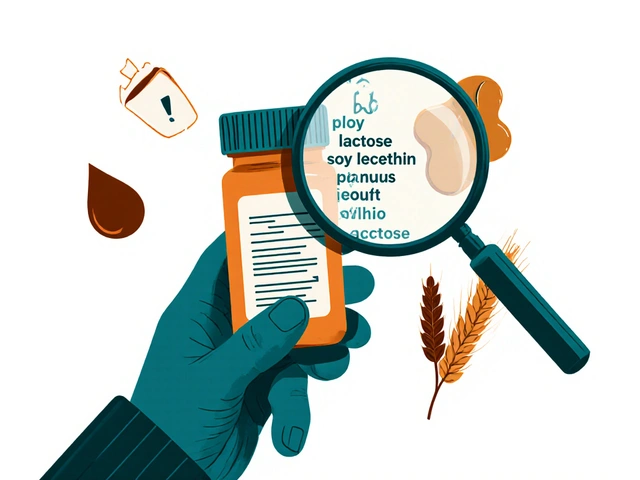
Imagine waking up in the middle of the night, struggling to catch your breath. That’s a reality for too many Australians with asthma or COPD. My son Blair had a scare last winter—watching your kid clutch their chest is terrifying. For families like mine, finding the right long-term inhaler isn’t just another health decision. It’s about sleep, safety, and being able to kick a footy around the park without worry. The ICS/LABA combo inhalers—specifically Dulera and Symbicort—are front-runners for families facing this everyday battle. But how different are they really? There’s plenty of buzz, a few myths, and more than a little confusion at chemists across Sydney.
Breaking Down the Science: How Dulera and Symbicort Work
Both Dulera and Symbicort pack a one-two punch: an inhaled corticosteroid (ICS) and a long-acting beta agonist (LABA). Dulera combines mometasone (ICS) with formoterol (LABA), while Symbicort pairs budesonide (ICS) with the same LABA, formoterol. But here’s the thing—mometasone and budesonide work differently in your lungs. Mometasone is known for its potent anti-inflammatory effects, needing smaller doses for a strong response. Budesonide, on the other hand, is fast-acting and well-tolerated, but may require higher daily doses to keep inflammation under control, especially during allergy season.
Formoterol brings rapid relief, often kicking in within minutes, but keeps working for up to 12 hours. That’s the beauty of these combos; you’re not stuck waiting for ages to breathe easier. For some folks, especially kids or the elderly, this quick onset means fewer emergency dashes to the hospital. What’s fascinating is that Symbicort’s unique delivery lets it double as a rescue inhaler in some asthma plans (the SMART or MART approach). Dulera, at least for now, is only used daily for maintenance.
Let’s get a bit nerdy and look at a quick comparison of their components:
| Product | ICS | LABA | Onset of Relief | Dual Use |
|---|---|---|---|---|
| Dulera | Mometasone | Formoterol | 1-5 minutes | No |
| Symbicort | Budesonide | Formoterol | 1-5 minutes | Yes (with SMART protocol) |
Some studies suggest mometasone’s stronger ICS effect might reduce flare-ups more effectively, but real-life results can be unpredictable when you add in every day triggers like pollen and cold viruses. Neither product can make you invincible, but both have solid science behind them. And if your asthma or COPD is tricky, your doctor might tweak which ICS you use, but formoterol’s quick action is a game-changer for both options.
Dosing Convenience: Which Inhaler Fits Real Life?
Ever tried teaching your eight-year-old to inhale just right? Or remembered your own medication after a long day at the office? Convenience matters—a lot. Both Dulera and Symbicort are pressurized metered-dose inhalers (MDIs), but the dosing and usage instructions aren’t identical. Dulera typically comes in two strengths for adults: 100/5 and 200/5 micrograms per actuation, given as two puffs, twice a day. Symbicort offers 100/6, 200/6, and 400/12 micrograms per puff. For maintenance, it’s usually two puffs twice a day, but the real twist is its flexible use: Symbicort’s “SMART” dosing allows extra puffs for relief during flare-ups, up to a safe daily max.
This flexibility—using one inhaler for both daily control and as-needed relief—simplifies the routine for forgetful teens and busy parents. I’ve seen families ditch the separate blue puffer entirely, relying on Symbicort’s quick onset for sudden symptoms. Dulera doesn’t have this approval; it’s strictly for regular use, and you’ll still need a separate rescue inhaler handy. On busy sports days or holidays, that’s one less thing to carry.
Here are some key differences in daily routines:
- If you need a backup inhaler at the beach or gym, Symbicort covers both bases with one device (within guidelines).
- Dulera sticks to a fixed schedule—great if you like routine but less ideal if you sometimes need more flexibility.
- Both require solid technique and regular cleaning. MDIs can clog if you skip rinsing the nozzle or don’t shake before spraying.
- Both inhalers are only effective when taken as prescribed—skipping puffs, even when you feel fine, leads to trouble later on.
Paediatric patients (over 12 for Dulera, over 6 for Symbicort in Australia) and adults often have different preferences. My kids, for instance, hate taste changes from some inhalers. Taste, aftertaste, and the cloud size vary, and that can be a deal-breaker for teens who already dislike inhaler routines.
Bottom line: Both work if you stick to the instructions, but Symbicort edges out Dulera for sheer flexibility, especially for those who value a streamlined routine or the confidence of having relief and control in a single stick.

Side Effects, Real-World Tolerability, and Safety
No one likes seeing ‘possible side effects’ in bold print. But here’s where the differences get interesting. The most common issues with ICS/LABA combos are oral thrush (from steroid deposition in the mouth), hoarse voice, and coughing right after a puff. I’ve had to coax Blair into rinsing his mouth every single time—such a simple trick, but it cuts the odds of thrush more than half. Both Dulera and Symbicort share these risks, but mometasone’s higher potency means you might get by with a lower dose, possibly reducing steroid load. On the other hand, some adults notice slightly less cough or hoarseness on budesonide-based Symbicort. Taste perception is subjective, but patients do mention it at my local chemist’s all the time.
Other, less common risks: palpitations, sometimes shaking hands, or mild headaches—usually from the LABA (formoterol). If you overuse either inhaler far past prescribed limits, you risk adrenal suppression (from too much steroid) or heart strain. That’s why the SMART protocol is capped at a max number of puffs daily, and why mixing up maintenance and rescue inhalers without guidance isn’t advised.
Here’s a quick reference from recent Australian reporting (2024 data):
| Side Effect | Estimated Incidence (%) | Notes |
|---|---|---|
| Oral Thrush | 6-9 | Can drop by over 50% with mouth rinsing |
| Hoarse Voice | 3-7 | More common at higher doses |
| Minor Shaking | 2-4 | Short-lived if present |
| Headache | 2-5 | Typically mild, resolves on its own |
| Heart Palpitations | <2 | Rare, see doctor if severe |
There’s no evidence that one inhaler is universally safer or gentler than the other. What matters: sticking to the lowest effective dose long-term, never skipping annual asthma reviews, and paying attention to symptoms—especially during allergen-heavy months in Sydney.
One practical tip from my GP: if you struggle with the puffer and never quite get the timing, ask for a spacer. It makes a world of difference, both for delivering medication to the lungs and reducing throat/stomach side effects (this is especially true for younger kids and older adults). Spacers cost less than a night out—much less than a hospital visit.
Insurance Coverage and Cost Trends in Australia
Medicare and private insurance rules have shifted a bit in 2025. While both Dulera and Symbicort are covered by the PBS (Pharmaceutical Benefits Scheme), out-of-pocket costs can vary by brand, strength, and if you’ve hit your Medicare Safety Net for the year. Dulera’s generic competitor in Australia means it may cost slightly less at some chemists, especially if you’re not on a concession card. But Symbicort’s widespread use, plus that speedy relief option, keeps it highly prescribed, especially for patients with repeat hospitalizations.
One trend from last year: some insurers moved to restrict SMART/MART dosing unless there’s documentation of emergency visits—so your GP might need to justify the script every few months. Others bundled Symbicort with asthma action plan reviews, which isn’t a bad thing if you’re prone to skipping check-ups.
A growing number of patients look up alternative ICS/LABA combos when Dulera or Symbicort supplies run low. If you’re curious about side-by-side cost and efficacy, I recommend checking out the detailed Dulera vs Symbicort analysis. It digs into options if you ever need to swap brands due to cost, availability, or doctor’s advice.
Here are some money-saving tricks Aussies are using in 2025:
- Ask your GP for the lowest effective strength—those have the lowest co-pay.
- Always rinse inhalers and check expiry dates; wasted or expired inhalers mean wasted dollars.
- Warehouse chemists sometimes discount generics, but only accept TGA-approved brands.
- If you need frequent repeats, talk to your pharmacist—they might know of manufacturer loyalty programs or discounts for multi-pack purchases.
The PBS includes both brands with authorizations, but supply chain hiccups (a hot topic the past few years!) sometimes make one easier to grab at late-night chemists. Flexibility can be as important as price, especially if you travel or have kids in multiple sports and need an inhaler in every bag.

Everyday Life: Finding the Right Combo for You or Your Child
Here’s the honest part: your ideal inhaler won’t come down to lab stats, GDP cost indexes, or even the textbook trial data. It’s about how the inhaler fits routine, lifestyle, and personal quirks. Kids with after-school sports might need Symbicort’s extra relief flexibility. Busy parents or shift workers might lean towards Dulera if it means a less complicated script, and the generics shave a bit off the family budget. App-based inhaler reminders (like MyAsthma or NPS MedicineWise) make it easier to stick to routines even on crazy days, and both inhalers can fit into these digital reminders with basic Bluetooth add-ons.
A real-life hack: keep a written asthma action plan in the glove box, one on the fridge, and snap a photo on your phone. Teachers, coaches, and babysitters should know exactly which inhaler you use, how many puffs, and what to do in a crisis. My daughter August used to panic at coughs, but now she confidently tells her school nurse which puffer she needs. Kids pick up on our stress; routine breeds calm.
For those struggling with inhaler technique (and it’s more common than you’d think!), using a spacer and practicing with a respiratory nurse makes all the difference. And don’t ignore the power of peer groups—lots of Sydney parents share tips in school WhatsApp chats about wresting inhalers from stubborn kids or how to store them in the summer heat.
Annual reviews are a lifesaver—literally. If asthma or COPD symptoms aren’t staying controlled, ask for a script review. Sometimes a tiny tweak in dose, or a switch from Dulera to Symbicort (or vice versa), changes the game completely. Pharmacists now have more power in 2025 to consult and adjust asthma plans, so don’t hesitate to ask them too, especially if waiting weeks for a GP appointment is a headache.
You can read up on more options (and the nitty-gritty pharmacy costs) if you’re weighing the switch—again, the Dulera vs Symbicort analysis is a goldmine for getting real-world comparisons without the sales pitch.
Your choice might change as kids get older, seasons change, or new generics drop prices. If you’re waking at night or using a puffer more than recommended—talk to your team. Life’s too short for breathlessness. The best combo? It’s the one that keeps you, your kids, or your parents comfortable, confident, and doing what you love. And if it means a few extra moments brushing your teeth and rinsing after puffing—trust me, it’s worth it for a good night’s sleep.
Karla Luis
Okay but have you actually looked at the pharmacokinetic profiles of mometasone vs budesonide in pediatric lung deposition? The 2023 ERS study showed budesonide’s particle size distribution gives it a 22% higher alveolar uptake in kids under 12-so yeah Symbicort’s not just convenient, it’s biologically superior for growing lungs
Kenneth Narvaez
Formoterol’s off-label use as rescue therapy in SMART protocol is still not FDA-approved for all age groups. The GINA 2024 guidelines explicitly caution against extrapolating adult data to adolescents without FeNO monitoring. You’re trading convenience for unquantified risk.
jon sanctus
Bro I used Dulera for 18 months and my voice sounded like a broken kazoo every morning. Then I switched to Symbicort and suddenly I could sing in the shower again. It’s not rocket science. The taste? Like a faint metallic lemon. The thrush? Gone after I started rinsing. Why are we overcomplicating this?
mona gabriel
It’s funny how we treat inhalers like they’re sneakers. You don’t buy the most expensive pair because it’s branded-you buy the one that doesn’t give you blisters. Same here. If your kid’s not crying every time they use it, you’ve already won. Just rinse. Always rinse.
Phillip Gerringer
People are treating this like a consumer product review. This isn’t about convenience. It’s about steroid burden, systemic absorption, and long-term adrenal suppression. You’re not just picking a flavor-you’re choosing a physiological trajectory. And if you’re using SMART without a written action plan, you’re gambling with your kid’s endocrine system.
jeff melvin
Symbicort’s flexibility is a trap. You think you’re saving time but you’re just normalizing overuse. I’ve seen teens hit 12 puffs a day because they forgot to refill their blue puffer. The body doesn’t care if it’s the same device. Formoterol is formoterol. Dose is dose.
Matt Webster
I work with a lot of families who are overwhelmed. If Symbicort means one less inhaler to carry, one less thing to explain to the school nurse, and less panic during sports day-it’s worth it. The science is nuanced, but the human need is simple: less stress, more breathing. Don’t shame the practical choice.
Hamza Asghar
Wow. You all sound like you’ve never read a Cochrane review. Let’s be real-the 2024 meta-analysis in Thorax showed no significant difference in exacerbation rates between Dulera and Symbicort when adjusted for adherence. But you? You’re all obsessed with the ‘rescue’ narrative because you’re too lazy to follow a regimen. And yes, I know you’re all using the same spacer technique wrong. You’re shaking it like a cocktail shaker. Stop it.
Christian Mutti
My daughter was on Dulera for six months. She developed oral thrush. Then I switched her to Symbicort. She started using it as needed. She went from missing two soccer games a month to playing in the state finals. I’m not a doctor. I’m a dad. And I’m not apologizing for giving her the best shot at a normal life.
Liliana Lawrence
PLEASE. Please. Please. Please. Please. Please. RINSE. YOUR. MOUTH. After. EVERY. PUFF. I’m not even mad anymore. I’m just… tired. Like, emotionally exhausted. My cousin’s kid had to get a steroid injection because they didn’t rinse. Like… what? Why? Why is this not taught in kindergarten? 🤦♀️💧
Sharmita Datta
Have you considered that both drugs are patented by multinational pharmaceutical corporations who benefit from confusion? The real solution is nebulized budesonide in public schools, not more inhalers. The government knows this. But they’re too busy accepting donations from AstraZeneca to act. Wake up. This is not about science. It’s about profit.






Write a comment